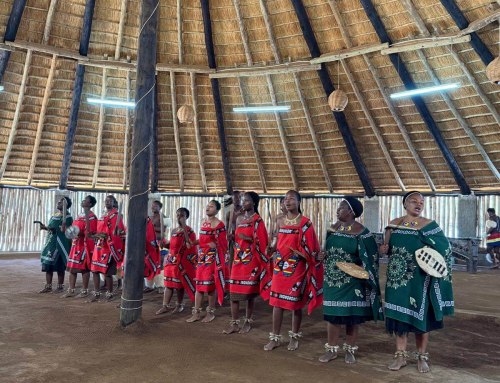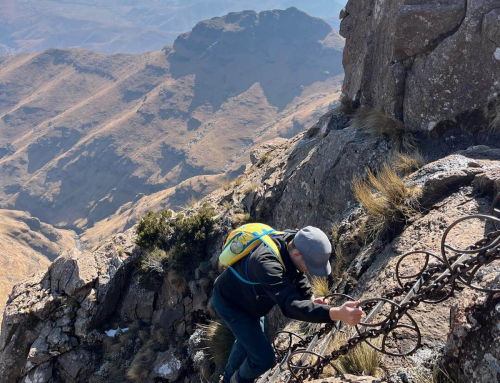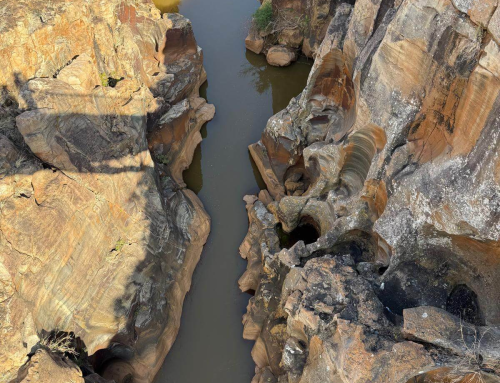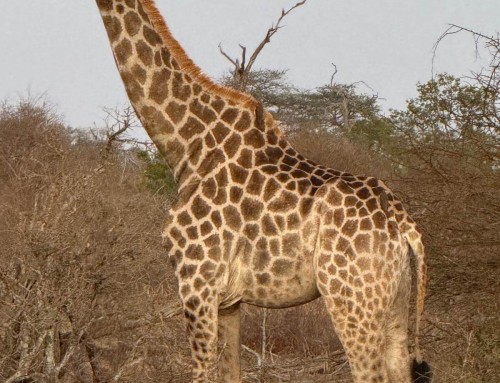Kruger National Park
So you want to see wild animals up close? You’ve come to the right place. South Africa is full of amazing wild animals like lions, giraffes, zebras, you name it! But where do you go to see them? The best place in South Africa is Kruger National Park. This park is one of the largest national parks in the world at 19,500 km square, about the size of the state of New Jersey!



Even with its massive size, it is very well run and managed. The gates open and close at precise times (check their website as it changes seasonally). The gate times are not suggestions, they are very strict about it. There are even additional fees if you don’t exit by the right time. They don’t mess around. The facilities are excellent including bathrooms that are always stocked with toilet paper. They have a few picnic spots where you can bring your own food, bbq grills to rent, and tables to sit at outside. There is even a Mug & Bean coffee shop and restaurant at the Lower Sabie Rest Camp which has a beautiful view. During our lunch, we watched a leopard eating its meal in a tree across the river! I’d recommend a stop for lunch here.
Three Regions of Kruger National Park
Kruger is typically broken into three regions: northern, central, and southern. Each area boasts its own unique or special trait. So which one to visit? Well it all depends on what type of animal you are looking for. Can you go to all three regions? Yes, but it’s quite a long drive so make sure you check drive times, find places to sleep, and bring food to eat.
Southern Kruger is generally more accessible with drivable roads, a coffee shop, great facilities, and closer to the airport and other accommodations. The southern side generally receives more rain so it attracts more cats like lions, leopards, and cheetahs (we saw all of them multiple times!). This side also attracts large herds of elephant and buffalo. For these reasons, the southern part near the Crocodile Gate is our recommendation for first time visitors.
Central Kruger has large swaths of open savannah which makes it perfect for herds of impala, zebra, wildebeest, kudu, and giraffe. The camps here are really beautiful, one is even located on a cliff top. Northern Kruger is known for its rolling landscape of mopane trees, a favorite of the large elephants. The woodland area also attracts herds of buffalo, elands, and sables. Lions, leopards, and rhinos are less numerous here. However, there is a higher density of birds up in the north.



Safety in Kruger National Park
Most of this knowledge came from our guide. He has been living, working, and exploring the Kruger for 30 years and said he’s never been attacked by an animal as long as you follow guidelines. There is absolutely no getting out of your vehicle or putting limbs outside the windows. There are designated areas for bathroom, eating, and even gas stations where you’re allowed to get out of the vehicle. But getting out of the vehicle on the road is against the rules for everyone’s safety. Guides will actually take pictures of people out of their vehicles and report the offender to the Kruger office. The office staff can either find you in the park or give you a monetary fine so don’t do it. Also never block an animal’s path on the road. A few times we saw elephants, lions, impala, and giraffes crossing the road. Stay back, turn your car off to limit noise, and let them do their thing.
Where to Stay in and around Kruger National Park
One very cool feature of the park is that there are nice camps inside the park. Yes that’s right, you can pay to sleep in the park. These areas are fenced off so the animals won’t attack you. You may have impala walking around and grazing on grass near your lodging but they won’t hurt you. There is a mix of dirt ground campsites where you can either pull up an RV or camper or pop a tent. There are also nicer accommodations with beds and walls if that’s more your style. Reminder that if you are staying in the park, the gates open and close at specific times so you cannot come and go as you please. Bring all the food and drinks you need for your time here.
Another option to have the feel of inside the park is the private game reserves that are next to Kruger. There are no fences separating the land so animals can come and go but the private game reserves are privately owned meaning their safaris jeeps can drive wherever they want. These luxury resorts tend to be much pricier to stay at but you get the elegance with the inside the park feel.
We opted to stay just outside the park. We really enjoyed our stay at Marloth Park. This area is situated at the southern part of the park with the closest access being Crocodile Gate. On the map you can see that there are hundreds of hotels and self catering houses to rent. However, when you are there, it’s so hard to see any of them as the trees block your view. It’s the closest you can get to being in the park without being in the park. This provided us with normal accommodations, a few restaurant options, and was the perfect place to meet our safari guide, more on that below.
Driving Through Kruger National Park
So now that you’ve picked a location to visit, how do you actually see the animals? There are two different ways you can experience the thrill of seeing the animals. Our preferred way is by a paid safari guide and the second way is a self-drive in your own car. I’ll give you some of the pros and cons of each way and you can make the decision yourself.
Guided Safari in Kruger National Park
We decided to go on a guided safari tour for a few reasons. First, everything from entrance tickets to logistics is done for you. It just made it so much easier. I know it sounds lame but when there are only a certain number of cars allowed in daily, it was important that we didn’t miss our chance to get in on the exact day we were there.
Second, for us, we are paying for the knowledge the guide has and wow, did our guide have so much knowledge. We’d see a bird or animal and ask “what’s that?” and he’d tell us the name instantly. We saw many people driving themselves flipping through guidebooks trying to find the names of animals or identify what they just saw. Speaking of our guide, he gave so much additional information like the story behind the fever tree, the mystery of the private security guards for the oldest rhino, and how to track animals with paw prints and droppings. He’d know when to keep moving or when to stop and look for the animals based on his years of knowledge tracking animals.
Third, the guides also are all on a chat group together so when one sees an animal, a message is sent out. This made it extra helpful so we weren’t aimlessly watching grasslands as many self driving are.
Finally, our guide was so good at pacing the trip. He’d make the right timed bathroom stops and lunch stops. Oh did I mention he brought snacks, hot tea for the morning, and cold drinks for the afternoon from the resort we booked.
So how can you have this same experience? We booked through Foxy Crocodile Resort and I highly recommend you use them too. Their service was top notch! The jeep came with extra things like blankets for the cold mornings, USB plugs to charge our phones, binoculars so you could see the animals well, and cold drinks for the hot afternoons.
We did two all day safaris. A lot of people we spoke with did 5-7 days but within two days we pretty much saw all the animals we wanted to see. Additional days seemed like an overkill to me but people said they traveled this far and wanted to see everything. So do as you’d like. I would recommend more than one day though because remember, these are wild animals. This is not a zoo. If the animals aren’t out, they just aren’t out. So some days are better than others. That’s why I’d recommend a few days if you can.



Self-Drive In Kruger National Park
While there were many people in the park driving themselves, there are a lot of things to consider. They only allow 350 cars per gate to enter every day. This means that especially during peak season, the entrance tickets can get sold out. If you go this option, make sure to book your spot online so you don’t get stuck out of the park.
In the morning, around 5:30 am cars start to line up. There is one line for safari jeeps, one line for online reservations, and one line for no reservations. If there are 350 online reservations, no one from the no reservations line gets in that day.
Once through the gate, they will check your car for firearms (to prevent poaching) and alcohol. After passing through the first gate, the registration process can take up to 30 minutes and is pretty manual (all of this can be avoided if you just used a safari company :) ).
Additionally, there are a few things that look frustrating to us as observers of others who choose to self-drive. To begin, someone has to drive the car which is obvious but that person doesn’t get to look around as much as the others. They are constantly paying attention to the road and other cars, especially when traffic picks up for a lion sighting. Next, cars are lower than the safari jeeps. Our safari jeep seats literally sat above the other cars so when cars pulled in front of us to see an animal, we could still see over them but other cars couldn’t so it looked hard to get a good view. Finally, someone has to pay attention to maps and driving instructions as there are many roads in Kruger and many patches of no cell phone signal.
Like we said, the guide’s knowledge was enough for us to pay for a safari since we learned so much about animals and got to ask as many questions as we wanted. But self-drive is definitely an option when it comes to seeing wild animals in Kruger if you want.
Conclusion
All in all you cannot go wrong with Kruger National Park, whether you choose to do-it-yourself driving or hire a safari. Whether you choose to sleep in the park or outside, it’s going to be a wonderful experience. You’ll be closer to wild animals than you’ve ever been and it’s truly an unforgettable experience.
Discover more from Penley Perspective
Subscribe to get the latest posts sent to your email.




